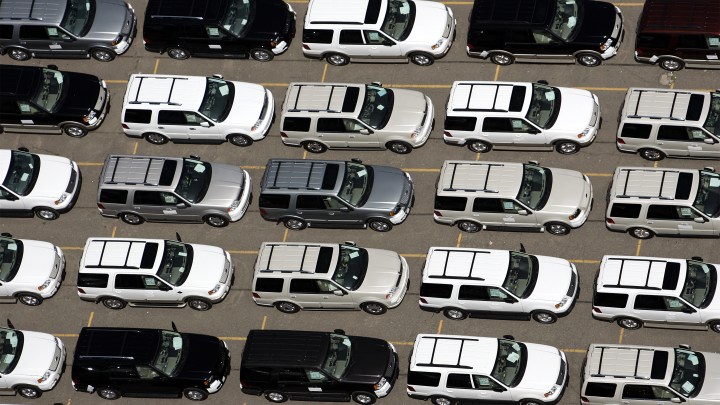
Buyers love SUVs, but experts warn they come at a cost to others
Buyers love SUVs, but experts warn they come at a cost to others

At the Insurance Institute for Highway Safety’s testing grounds in Ruckersville, Virginia, a figure dressed in blue jeans and a black jacket steps out at a good pace to cross the track. An SUV drives directly in his path, but he doesn’t look up.
The vehicle hits him at about hip level and flips him over the hood. Thankfully this is an experiment and the figure is a dummy. In other tests the impact breaks the dummy apart — legs go in one direction, torso and head in another. They’re sobering tests to watch.
Jessica Cicchino, vice president of research at the IIHS, says these tests are designed to rate the emergency braking systems some new vehicles come with.
“We have the dummy start to walk across the street, and we drive the car towards it and then hopefully if the driver doesn’t respond, the system will brake,” she said. Not all the systems work, though, and some vehicles strike the dummy without slowing down.
Safety campaigners say, despite any new technology, the sheer size of SUVs and trucks makes them more dangerous to anyone outside the vehicles. Pedestrian deaths have risen by 40% from a low in 2009.
Angie Schmitt, the author of the upcoming book “Right of Way,” about pedestrian safety in the U.S., said it wasn’t clear at first why pedestrian and cyclist deaths started rising, but she and others started to match the increase to the rise in larger vehicles that people have been buying since the end of the Great Recession.
In 2019, trucks and SUVs accounted for around 70% of new vehicle sales, and Schmitt sees a clear correlation to pedestrian fatalities.
There are other factors. More people are driving more miles since the recession, and smartphones mean more distracted drivers and walkers.
The perception of safety, inside the vehicle at least, is a key reason people buy SUVs. They like the higher seating position and better visibility. And automakers are happy to sell crossovers, SUVs and trucks, because the profit margins are higher than they are for small cars.
“We see decisions from some of the American car companies like Ford, Fiat Chrysler, and General Motors, to not even sell cars any more and to focus on building more efficient SUVs that can replace cars and that people will want to buy,” said Jessica Caldwell, executive director of insights at Edmunds.
There’s another consequence of the move to larger vehicles, say researchers. They have higher emissions because they use more fuel. The International Energy Agency, based in Paris, France, says that on average, SUVs use 25% more gas than sedans.
The trend towards more SUVs is “canceling out the benefits we have seen the last decade from the penetration of electric cars,” said International Energy Agency energy modeler Apostolos Petropoulos.
There’s a lot happening in the world. Through it all, Marketplace is here for you.
You rely on Marketplace to break down the world’s events and tell you how it affects you in a fact-based, approachable way. We rely on your financial support to keep making that possible.
Your donation today powers the independent journalism that you rely on. For just $5/month, you can help sustain Marketplace so we can keep reporting on the things that matter to you.












